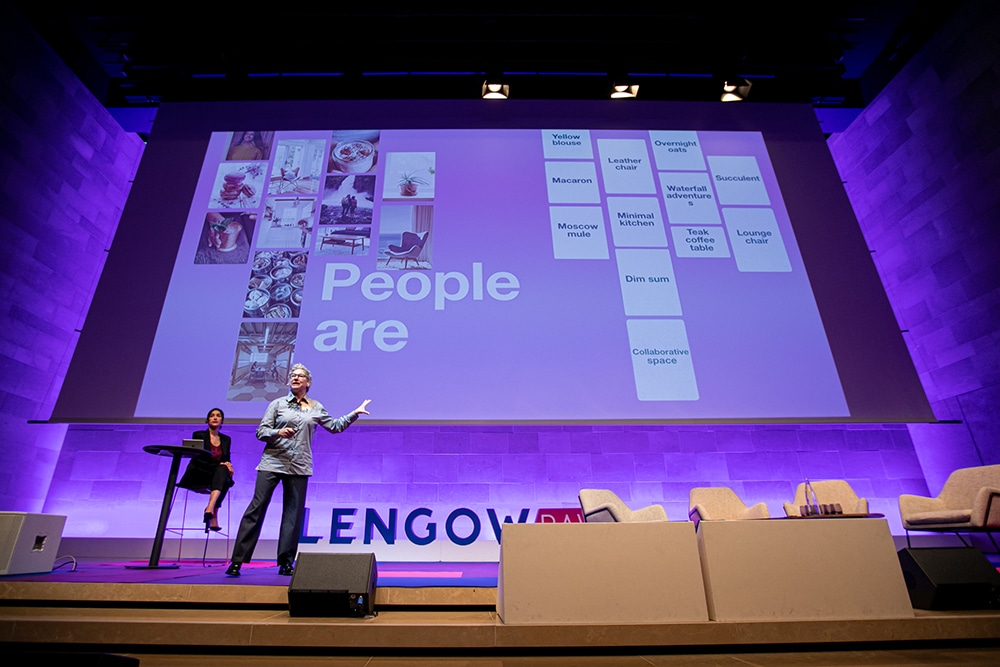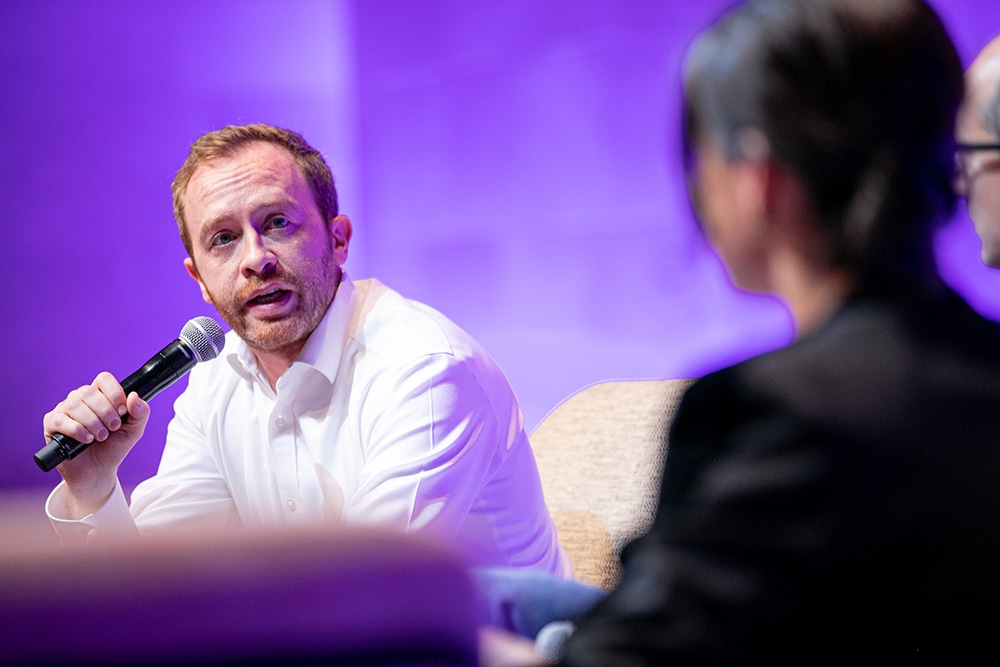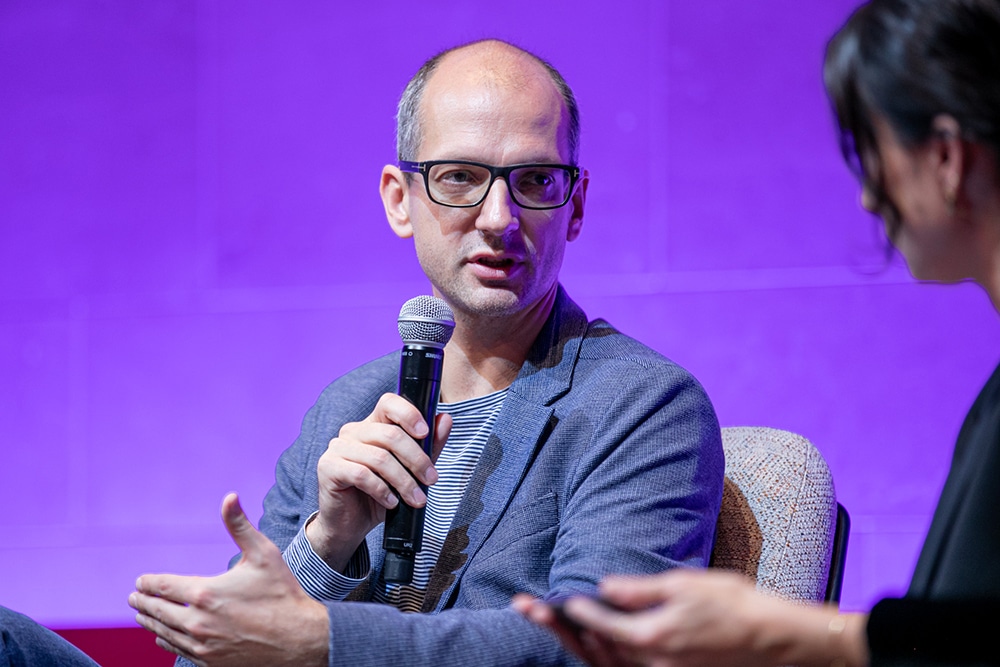Lengow Day 2019: key takeaways from this year’s event (part 1)
29/10/19
6'
Lengow Day 2019 was held on Tuesday 1st October. Dedicated this year to the future of (e)commerce, this year’s event brought together more than 550 international e-commerce players. In this article, we look back on the topics covered in the morning conferences!
Data at the heart of customer experience
Michelle Beeson, Analyst at Forrester, was the first to share her vision of the future of (e)commerce in a keynote entitled “What will the next generation of retail look like?”.

Multiplication of points of contact, new interfaces, technological developments, etc. Consumers who are now hyper-connected and equipped with multiple “devices” no longer make any distinction between digital and physical contact points when they interact, engage and buy from a brand or distributor. As a result, by 2020, 55% of retail sales in Europe will include digital contact points in one way or another.

Brands and distributors must prioritize their actions in this context: investments and strategic decisions must have the ultimate objective of serving the customer and improving the customer’s shopping experience.
To ensure the information and analysis needed to implement an optimal strategy is available, Michelle Beeson (Forrester) recommends having quality data to improve the shopping experience and a good knowledge of the customer to meet their expectations. The collection, quality and consistency of data shared between teams are therefore among the main challenges for companies, some of which still struggle to follow their customers throughout their purchasing process. Finally, to make the most of this data, Michelle Beeson (Forrester) stresses the importance of quality collection and good communication between the company’s various departments.
Go further
Inspiration at the heart of the visual search engine
Amy Vener, Head of Retail Strategy at Pinterest, discussed the role that Pinterest plays for its 300 million monthly active users and how the visual search engine helps brands create an emotional bond with their customers. Firstly, unlike traditional search engines that provide a concrete answer to a query, Pinterest offers a search experience that is more focused on visual discovery.
84% of Pinners use Pinterest every week when they are actively considering buying a product/service.
House renovation projects, meals to cook, changing your look… when users browse Pinterest, they are planning a project, but don’t yet know what they will purchase. This visual search engine provides Pinners the opportunity to find inspiration, and then to make significant purchases. It is also an opportunity for brands to offer “moments of inspiration”.
Today, Pinterest’s strategy consists of three components. The first concerns visual discovery that allows brands to forge a connection with the consumer. According to Amy Vener (Pinterest), a visual will always bring more emotion than a text.

The second is about taste-based personalization. Based on the data behind each of these pins, Pinterest offers its users the most relevant content possible according to their interests.
The third element on which Pinterest has been investing for several months: “Shoppable products”. Soon to be available in Europe, “Shoppable products” give buyers the means to move from inspiration to action by allowing sellers to showcase their products, highlight them within pins and then boost their visibility through Product Shopping Ads. In this way, the search engine increases the quantity of products within its ecosystem so that consumers have as much visual content as possible to discover.
To succeed on Pinterest, Amy Vener (Pinterest) recommends three ways to showcase your products:
- day-to-day decisions: the content you provide helps people make decisions.
- milestones: internet users use Pinterest to plan a project months in advance: the arrival of a child, starting college, moving house, etc.
- seasonal celebrations: Halloween, Christmas, Valentines day, etc. These periods are important to promote your products.
Finally, Amy Vener (Pinterest) discusses the notion of ROI at Pinterest, the Return on Inspiration. According to Amy, this indicator is an opportunity to make the consumer emotionally connected with your products and brand and to transform it into a transaction.
Social and (e)commerce: a winning duo
Still on the subject of social platforms we head from Albert Simsensohn, Head of EMEA eCommerce Partnerships at Facebook, and Ilya Shirokov, Co-founder of the mobile marketplace JOOM. These two players in the sector who made the bet to mix social and commerce with their marketplaces to offer a quality shopping experience to consumers.
With Facebook, users can connect with the people/things they love (family, friends, products, brands and companies), as well as buy products within the social platform.
From social to e-commerce and from e-commerce to social, Albert Simsensohn (Facebook) identifies four purchasing behaviours:
- Intention to buy: the user knows exactly what they want to buy.
- Buying by comparison: the user knows what they need but wants to compare products before buying it.
- Window shopping: the user is in the mood to buy, but they don’t know exactly what they want.
- The unexpected purchase: the user does not really want to buy, but they discover something that inspires them and decide to act.

Ilya Shirokov (JOOM) also shares his vision of (e)commerce and social issues by addressing the evolution of traditional marketplaces. These have moved from a two-party format to a three-party format where consumers, sellers and influencers now coexist, representing a new sales channel for brands. This trend, which comes straight from China, is tending to become more democratic in the West. On this subject, Albert Simsensohn (Facebook) adds that conversational commerce is developing enormously in Asia and allows brands and buyers to interact throughout the buying process.
As for the trends to follow, Ilya Shirokov (JOOM) talks about the marketing influence and the speed of the transition from computer to mobile. In this regard, Albert Simsensohn (Facebook) points out that nearly 80% of the time spent online on mobile phones is spent on 5 applications. This adds the importance of personalization to the shopping experience. Users are now used to receiving fast and efficient service and want to enjoy a personalized experience based on their expectations, thanks to data and customer knowledge. He advises brands and distributors to eliminate all online and/or offline friction, from product discovery to after-sales service to gain a competitive advantage.

Ilya identifies three sources of friction within the sales funnel: discovery, transaction and after-sales. In the discovery phase, friction prevents buyers from finding the information they need to make a purchase. Once the item has been selected, the consumer then moves on to the transaction stage where there are many frictions: queues in stores, forms to complete online payments, etc. As for after-sales service, three areas are concerned: order fulfilment, returns and customer service.
Ilya Shirokov (JOOM) also compliments this list of friction points by citing that, on mobile, the attention span is so short that customers must be immediately shown what they want. Social platforms allow you to generate a relationship of trust from your customers via social platforms: the user experience must be of high quality for both buyers and brands.
Come back soon to (re)discover the topics that punctuated the afternoon’s workshops!
Image: Ohé!
Your e-commerce library
4 Top Tips for Selling on Marketplaces (Home and Garden)
Learn moreMarketplace Horror Stories
Learn moreMaster Intelligent Google Campaigns
Learn moreSign up for our newsletter
By submitting this form you authorize Lengow to process your data for the purpose of sending you Lengow newsletters . You have the right to access, rectify and delete this data, to oppose its processing, to limit its use, to render it portable and to define the guidelines relating to its fate in the event of death. You can exercise these rights at any time by writing to dpo@lengow.com

Trending Posts
Marketplaces
9 essential tips for selling on marketplaces (2024)
In 2024, selling on marketplaces is a real challenge. Rivalry between sellers is intensifying, and the range of marketplaces is…
18/01/24
7'
Marketplaces
How to Sell on Temu? Best Tips
Emerging under the vast umbrella of PDD Holdings Inc., Temu has skyrocketed in popularity as a shopping sensation from China…
17/08/23
5'
Marketplaces
The Top 10 Marketplaces in Europe
The e-commerce scene is a vibrant mix of marketplaces in Europe. These aren't just websites; they're bustling hubs where millions…
08/12/23
7'
Google Shopping
4 Must-have Google Shopping Optimizations [2024]
Google Shopping isn't just another advertising channel; it's the undisputed titan of paid e-commerce advertising channels. And why is that?…
11/01/24
9'
Price Intelligence
Winning with Pricing Strategy on Marketplaces
Selling successfully on marketplaces like Amazon and eBay hinges on how well you price your products. It's a balancing act:…
24/11/23
7'




